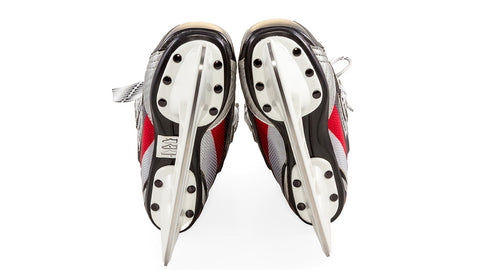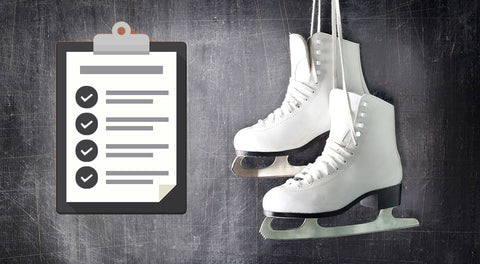Boot vs Blade: How to Find the Perfect Ice-Skating Shoes
jimActress Bette Midler once said, “I firmly believe that with the right footwear one can rule the world.”
Well, with the perfect ice-skating shoes, you can rule the rink.
Ice skating has been around for hundreds of years, and as the discipline has evolved, so have boots and blades.
Now, there are different ice-skating shoes and blades on the market.
Skates start at varying price points and possess different materials for different types of ice skating. It’s a confusing endeavor to find the perfect pair.
The right boot vs. blade can be the difference between giving up on skating and throwing your skates in a corner to rot and enjoying skating to the fullest for years.
PRACTICE ICE SKATING AT HOME WITH YOUR OWN POLYGLIDE SYNTHETIC ICE RINK
The perfect pair of ice skates enhances performance, provides stability, and encourages safety while giving you the speed and control that you desire.
We encourage skaters to look at the boot vs. blade, then assemble them to find exactly what they need.
Read on to learn some tips on buying the perfect ice-skating shoes.

Defining Boots vs Blades
For any discipline – figure skating, hockey, speed skating, and so on – the ice skate comprises the boot and the blade.
Boot Anatomy

The ‘boot’ is what you’ll be wearing on your feet when you hit the ice.
Boots are made of leather, nylon, canvas, or a combination of materials.
The boot has an outer shell and inner support.
The outer shell consists of the following:
- Quarter: The section that surrounds the ankle and lower leg, providing stability and support.
- The Toe Box: This part covers the toes and ball of the foot for maximum protection. The toe box is harder than the quarter.
- Tongue: The large, removable flap covering the instep and shin. You can shift the tongue around and secure it using the lacings or straps.
- Eyelets and Hooks: Laces pass through these holes to secure the ice-skating shoe. They distribute lace tension evenly and allow for adjusting the fit. Metal or plastic are common materials.
The inner shell consists of the following:
- Liner: The material on the inside of the quarter. It consists of a softer material and is perfect for insulation and on the ice. Liners also limit moisture from entering the boot. Common liner materials include fleece, foam, and microfiber.
- Ankle padding: Some ice skates have extra padding near the ankles for support and comfort.
- Footbed: A special padding that helps with shock absorption, perfect for figure skaters who execute jumps. Most are made of removable foam, cork, or silicone gel.
Blade Anatomy

Your ice-skating boots will need a blade to navigate the ice.
The bottom of your ice skates will have the following components:
- Soleplate: This is attached to the bottom of the boot with rivets and holds the blade in place while distributing forces. Some boots allow you to remove the plate.
- Blade Holder: Attached to the soleplate and holds the blade securely in place. Blade holders are made of metal, carbon, or similar materials.
- Blade: The blade is the long, sharp metal object attached to the sole of the boot. Blades are made of strips of carbon steel, aluminum, stainless steel, carbon fiber composite, or other materials. This blade cuts through the thin layer of water on the ice, allowing you to move with ease. Some blades are removable, while others are not. Blades have two edges with a concave shape in the middle. You can sharpen the blade to adjust this shape, called the radius of hollow.
- Blade Rocker: The curvature of the blade from front to back.
- Toe Pick: For figure skaters, there is a jagged protrusion at the end of the blade. This pick helps figure skaters perform spins and jumps.
Understanding these parts can help you select the best boot and blade for your needs. Now, it’s time for you to choose your boots and blade.

Get clear on the basics.
You must get very clear on your ice skating needs so you don’t buy incorrect skates.
Start by asking these questions.
Write down the answers so you can narrow your search.
- What is my ice-skating discipline/sport? - Is it figure skating, hockey, or recreational skating?
- Who am I buying it for? - Is it for an adult or a child?
- What is my current skill level? - Are you a beginner or seasoned skater?
- What’s my budget? - Skates and blades can range from under $100 to over $1,000.
- What are my goals? - Are you competing? Is it for recreational use? Are you moving up a level?
Once you narrow down your search, it becomes easier to land your perfect pair.
Brands like Jackson Ultima, Edea, Riedell, and American Athletic are popular figure skating and recreational boots.
Bauer, Riedell, CCM, True, and 5th Element are great hockey boot options.
Most of these brands come with the blade, but you can get separate blades from Bauer (hockey), Jackson Ultima, John Wilson, MK, and Edea.
Choosing the Right Boots
Now you know the reason, budget, and goals; you can choose the ideal boot for your needs.
- Remember that fit is king. Hockey and figure skating boots do not follow conventional sizing. Sticking to your regular shoe size can result in buying a boot that is too big or too small. Look at the sizing guidelines for the brand before purchasing. You want a snug fit (especially at the heel and ankle) that allows for tight control without damaging your feet.
- Beginners and intermediate figure skaters should also look for high-cut boots with stiff ankle support to prevent unwanted movement. Hockey players, on the other hand, may benefit from less restriction in this area to compensate for agility and quick turns. Mid-cut boots are great for recreational skaters, giving the right balance of comfort, control, and stability.
- Choose materials based on durability, price, and comfort. Leather offers excellent support and longevity but requires break-in and can be heavier. On the other hand, synthetic materials are easier to break in but break down faster. Some materials, like carbon fiber skates, allow for a more customized fit. Beginners should start with small investments and move up to higher quality boots over time, as these boots can keep up with the demands of professional skaters.

Choosing the Right Blades
When selecting ice-skating blades, consider blade length, type, profile, and material to match your skating style and skill level.
- The standard blade is 8-12 inches, depending on the sport. Choose a blade length based on your skill level and individual goals.
- Blades are strips of steel with added carbon, which are then coated with nickel or chrome. The material can impact performance. For instance, advanced blades use higher-grade steel for sharper edges and smoother flow. Some stainless steel blades have lightweight aluminum alloy chassis for increased jump height. Get feedback from a coach or technical expert if you’re torn between two or more options.
- The blade has a rocker, which is the curvature of the blade from toe to heel. Select a rocker based on speed, stability, or lift for jumps. Combining rocker with the perfect hollow can make your skate move through the ice like a knife through butter.
The goal is not to buy the most expensive blade but the one that will provide long-lasting performance.
Online or In-Person?
You’ll have the option of buying ice skates online or in a skate shop.
Online shopping opens you up to all brands, fits, and blades that most skate shops don’t carry.
You’ll also have no problems finding your size.
At the same time, if you don’t like the fit, you’ll need to go through the return policy process, which can cost you valuable time.
Skate shops can help you find the perfect fit, allowing you to try on multiple boots before deciding on the best one.
They can sharpen your blades and even “bake” your boots.
At the same time, you’ll be limited to the brands in the skate shop, which tend to be higher priced.

Try these popular options

Finding the right ice skates can be a challenge.
But you don’t have to search for boot and blade separately.
Here are some boot and blade combos that are durable, high-performing, and affordable.
- Riedell 10 Opal Beginner Figure Skates
- American Athletic Ice Skates
- Bauer Vapor 2X Pro Hockey Skates
- CCM JetSpeed FT670 Hockey Intermediate Skates
- Jackson Ultima Softec Vista Recreational Skates
- Jackson Ultima Freestyle Fusion Ice Skates
Putting it all together
Picking up the right pair of skates is easier said than done.
You need the right combo of boot fit and blade performance.
Once you understand the anatomy of ice skating boots, you can choose a more comfortable pair for your sport of choice.
The same goes for blades.
Once you discover that all steel blades aren’t created equally, you can find a set that can lasts longer, helps you skate faster, and even jump higher.
Give boot vs blade the same attention and care, and you’ll come out with the perfect pair you can use for years.
Happy skating!




